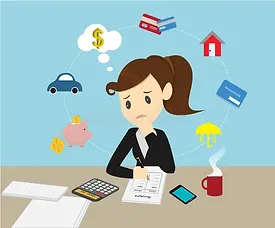The Impact of Interest Rates on Managing Debt
Credit cards, personal loans, and mortgages. While it can be easy to pick up debt as you go through life, changing interest rates, workplace interruptions and other life changes, can make it much, much harder to repay that debt.
A few simple tips can make the task a lot easier.

Taking Stock of Your Debts
First, know exactly what debts you have. If necessary, write a list of every debt you have, detailing the exact amount outstanding, the rate of interest being charged, including both the interest rate and the dollar amount charged each month and the time required to repay that debt.
If you are unsure of any of these details, contact the debt provider so you can make this list as accurate as possible, listing the debts from the smallest amount to the largest amount you owe.
Unravelling Interest Rates and Charges
Second, understand the exact rate of interest you owe on each debt and how this interest is charged against your account. Typically credit cards will attract the highest rate of interest but will only do so if you don’t pay the full amount that is owing each month.
While the annual interest rate charged on a credit card is usually very high, it is typically charged daily, so the actual amount charged can be much higher than you expect it to be. Each credit card will have its own interest rate rules and can have different rates for cash withdrawals compared to normal purchases.
In comparison, the interest rate on your home loan will be much lower and much simpler to work out. While it is charged on the daily balance, it is usually accrued to your loan at a specific day in the month and so it can be easy to reduce you overall interest charges by paying fortnightly for example, rather than monthly.
Be aware of any additional charges relating to any of your debts. These might include late payment fees or other penalties should you miss a payment date and depending on the debt, can be very high.
Penalty fees can be a big issue with buy now, pay later finance. Typically, the charges associated with this debt is carried by the retailer or service provider, but should you miss a payment, you can find yourself paying significant penalties on these loans.
Prioritising Debt Repayment
Third, order your debts, usually from the smallest debt to the largest, and then focus on repaying the smallest debt as quickly as possible. Once this debt is repaid, then you can divert the payments you would normally pay to that debt, to the next smallest debt and repay that debt as quickly as possible.
Typically, the smaller the debt and the faster you repay it, the less interest you will be charged. Some debts have a fixed rate of interest attached to them, so you still pay the same amount of interest no matter how quickly you repay the debt. These debts should be repaid last.
Exploring Debt Consolidation
It is possible to consolidate expensive debt, typically credit cards, into cheaper debts such as your home loan and this can make good sense if you are disciplined and can stop accruing credit card debts you can’t repay. Otherwise, this can be an easy way to make your debt burden even worse.
Upholding Timely Debt Payments
Ensure you always make your debt repayments on or before the due date. This is important as it will impact on your credit rating, which the banking system generates for every Australian who borrows money.
If you pay your debts on time, then your credit rating will be high, and you will be able to obtain credit at the cheapest possible rate in the future. If you let you credit rating slide, you will face a higher interest rate and, in some cases, might not be able to borrow at all.
Seeking Help When Necessary
Finally, if you are having trouble repaying your debts, contact the credit provider directly as they may be able to offer you some assistance in terms of reducing the rate of interest being charged or freezing all interest charges for an agreed period of time.


